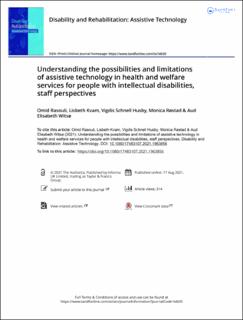| dc.contributor.author | Rasouli, Omid | |
| dc.contributor.author | Kvam, Lisbeth | |
| dc.contributor.author | Husby, Vigdis Schnell | |
| dc.contributor.author | Røstad, Monica | |
| dc.contributor.author | Witsø, Aud Elisabeth | |
| dc.date.accessioned | 2023-01-17T13:00:47Z | |
| dc.date.available | 2023-01-17T13:00:47Z | |
| dc.date.created | 2021-08-12T22:18:43Z | |
| dc.date.issued | 2021 | |
| dc.identifier.citation | Disability and Rehabilitation: Assistive Technology. 2021, 1-9. | en_US |
| dc.identifier.issn | 1748-3107 | |
| dc.identifier.uri | https://hdl.handle.net/11250/3044042 | |
| dc.description.abstract | Purpose: Little is known regarding what assistive technology (AT) exists and how it is used in welfare services for people with intellectual disabilities (ID). This study aimed to explore healthcare staff’s perspectives and insights regarding AT in daily support and welfare services for people with ID. We also sought to explore the associations between the use of AT and workplace-related factors and background characteristics (e.g., gender, age, and experience). Materials and methods: Three focus group discussions were conducted with 11 informants (8 women, 3 men) working in home-based and day services. Also, 176 healthcare staff (43 men, 133 women) who worked in municipal home-based services and day services completed a questionnaire comprised of background questions and 14 items with a five-point answer scale. Results: Number of years using AT was positively associated with a positive attitude and use of AT among the staff. Staff were mainly positive towards AT and believed that it could represent various possibilities in the everyday lives of people with ID and their own service delivery. However, the staff expressed uncertainties and ethical concerns regarding AT, and they experienced a lack of knowledge, focus, and awareness about technology in services for this group. The quantitative results mainly showed positive associations between believing in AT’s usefulness and using it in services for people with ID. Conclusions: The findings indicate that providing equipment and resources, personal interests, and staff attitudes are essential factors in successfully implementing AT for people with ID. | en_US |
| dc.description.abstract | Understanding the possibilities and limitations of assistive technology in health and welfare services for people with intellectual disabilities, staff perspectives | en_US |
| dc.language.iso | eng | en_US |
| dc.publisher | Taylor and Francis Group | en_US |
| dc.rights | Attribution-NonCommercial-NoDerivatives 4.0 Internasjonal | * |
| dc.rights.uri | http://creativecommons.org/licenses/by-nc-nd/4.0/deed.no | * |
| dc.title | Understanding the possibilities and limitations of assistive technology in health and welfare services for people with intellectual disabilities, staff perspectives | en_US |
| dc.title.alternative | Understanding the possibilities and limitations of assistive technology in health and welfare services for people with intellectual disabilities, staff perspectives | en_US |
| dc.type | Journal article | en_US |
| dc.type | Peer reviewed | en_US |
| dc.description.version | publishedVersion | en_US |
| dc.source.pagenumber | 1-9 | en_US |
| dc.source.journal | Disability and Rehabilitation: Assistive Technology | en_US |
| dc.identifier.doi | 10.1080/17483107.2021.1963856 | |
| dc.identifier.cristin | 1925713 | |
| cristin.ispublished | true | |
| cristin.fulltext | original | |
| cristin.qualitycode | 1 | |

